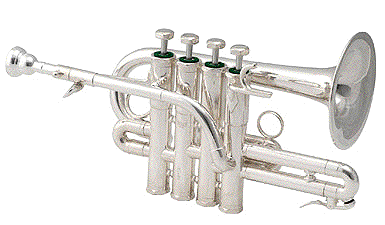Schilke built its first piccolo in September of 1966, without a model number and simply called The Piccolo Trumpet. For a picture of the early three valve version, click here.
Over the years, many prototype and custom instruments have been made, with various model numbers (including P1, P2, P3, P5, and P8) which are no long available, though probably could be had through a custom order. The current catalog and price list includes models described below.
All Schilke piccolos come with a cornet mouthpiece shank and a single leadpipe which can be pulled out from the key of B flat to the key of A. An additional leadpipe in the key of A is available, but must be ordered from Schilke separately at extra cost.
- P5-4
One of the Schilke company's most popular horns. It remains the benchmark for all piccolo trumpets and its introduction in 1971 revolutionized piccolo trumpet playing. Most manufacturers have consciously copied the P5-4 when designing their most recent piccolos. It has four valves and a medium bore (0.450 inch) that is significantly larger than the small bore (around 0.415) piccolos made in the French tradition which previously dominated the market. It also has expanded valve bows and large bore piston ports. These differences are immediately apparent and make the horn far more free blowing than any previously. It has a scale and playability far better than than the smaller instruments. Since at least 1979 or so all P5-4s have come with beryllium bells standard. Notwithstanding its premium price (list price: $2,675, as of September 2007), one rarely encounters retailers who sell them at anything like the usual discount for musical instruments. They are somewhat difficult to find used, which also must mean something. Yet many feel that the company would sell just as many even if the price were $500 more, the horn is so superior to others on the market. No single trumpet dominates any portion of the trumpet market more thoroughly than the Schilke P5-4, and the combined sales of the other Schilke piccolos is only a fraction of that of the P5-4.
There is an extra cost factory modification available which adds a first valve trigger and third valve ring called the P5-4 BG, the Butler-Geyer conversion, after Charles Geyer and Barbara Butler, the husband-wife team who were previously trumpet professors at Eastman, now at Northwestern University.
There is
another extra cost factory option (pictured at the left), designed at
the request of Maurice André and called the P5-4 MA. This is
an additional 4th slide assembly which lowers the pitch one whole
step for more easily-excecuted trills useful for J. S. Bach, etc.
Clifford Blackburn, Gerald Endsley, Dennis Najoom, and Osmun Music all currently make aftermarket leadpipes for the Schilke P5-4..
The Schilke P5-4 is played by by Adolph Herseth of the Chicago Symphony, Philip Smith of the New York Philharmonic, Ray Mase of the American Brass Quintet, Allen Dean of the Summit Brass, and Fred Mills, formerly of the Canadian Brass, and Wynton Marsalis, to name only a few. Maurice André, between his endorsement deals with Selmer and Stomvi, played the Schilke P5-4. It clearly dominates the market, even with cost no object.
There was a Schilke P5 (pictured nearby), which only had 3 valves
and came with an optional 3rd valve slide containing a rotary valve
that made it the third valve the functional equivalent of a fourth
valve, similar to the design of the Yamaha YTR 9850, although the
Yamaha has a tighter wrap of the bell.
- P4
The P4 is listed in the company's current price list, but is not included in the catalog. It is similar in bore and bell to the P5-4, except it has only three valves.
- P7
This was originally a smaller bore (0.437 inch), three valve horn similar in design to the original P5 above. The first was built in 1971, but the next in 1982. It remained in the catalog, but not in the price list, and sells in very small numbers. In 2003, the P7 was built with the same valve cluster as the P5 and the bore enlarged to 0.450. Schilke provided a P7 to Rick Baptist for use in the Los Angeles studios and was thrilled with the sound and the blow. Since then, Schilke developed the P7-4.
- P7-4
This is Schilke's newest design (pictured below), a 4 valved short model, advertised as being "a freer broader blowing piccolo" that "blend[s] exceptionally well with larger keyed trumpets.' It has as standard a first valve saddle and third valve ring to aid intonation, as well as separate B flat and A leadpipes. It has the same bell taper as the P5-4. These are new and very popular and hard to get. Apparently Rick Baptist ran off with one of the first and has been amazing the Hollywood studios with his new picc. He's written me twice to tell me how much he likes it. It will likely eat into the popularity and market dominance of the P5-4 since they are priced the same.

The design is similar to the original Schilke piccolo design, pictured here.
- C5-4
This is Schilke's only currently available piccolo in C and Schilke's smallest trumpet. It was first built in 1976 and has the same bore as the P5-4 but comes with a detachable herald style bell. Production on these horns very small, averaging three or four horns per year. It lists for the same price as the P5-4.
© 1999 - 2008 by James F.
Donaldson
All rights reserved